Even though this phrase means a rare event, it does refer to a natural phenomenon when there are two full moons in a calendar month. This occurs about once every 2.5 years. However, this New Years Eve's blue moon is rarer still--it happens only once every 19 years.
Happy New Year and a Blue Moon to everyone.
Wednesday, December 30, 2009
Thursday, December 24, 2009
'Tis the Season for Mondegreens
I'm not a big fan of Christmas music, but hearing Winter Wonderland reminded me of how my eight-year-old mind heard this Christmas classic. Because I didn't know what a Parson was, I heard:
In the meadow we will build a snow man
And pretend that he is parcel brown
Further along in the song I heard:
Later on we'll perspire as we dream by the fire
So when I saw Miss Cellania's recent post on Christmas Mondegreens it put me in the mood to visit my favorite site for misheard lyrics whose url contains one of the most famous mondegreens: 'scuse me, while I kiss this guy. This site requires a SPEW WARNING else you'll be mopping up your monitor while counting head lice on the highway
from Tiny Dancer or watching as the girl with colitis go by the Beatles.
Here are three of mine that may or may not be on this archive.
The Beatles: But the fool on the hill / Sees the sun going down / And the ice in his hair / See the world spinning round.
Janis Joplin: Take another little piece of my hard on baby
Abba: Wannado, couldn't escape if I wanted to
In the meadow we will build a snow man
And pretend that he is parcel brown
Further along in the song I heard:
Later on we'll perspire as we dream by the fire
So when I saw Miss Cellania's recent post on Christmas Mondegreens it put me in the mood to visit my favorite site for misheard lyrics whose url contains one of the most famous mondegreens: 'scuse me, while I kiss this guy. This site requires a SPEW WARNING else you'll be mopping up your monitor while counting head lice on the highway
from Tiny Dancer or watching as the girl with colitis go by the Beatles.
Here are three of mine that may or may not be on this archive.
The Beatles: But the fool on the hill / Sees the sun going down / And the ice in his hair / See the world spinning round.
Janis Joplin: Take another little piece of my hard on baby
Abba: Wannado, couldn't escape if I wanted to
Friday, December 11, 2009
New Richard III blog added to list
I recently learned of the New South Wales chapter in Australia of the Richard III Society and have added their site to my blog list. You can explore their site here.
I'm a member of the American branch and am active in the New England chapter. We are going to have our annual holiday luncheon this Sunday at the Colonial Inn in Concord, Massachusetts.
We Ricardians and others who are interested in that period of English history are scattered across the globe, many of us in remote places where access to resources is often difficult obtain.
While I'm not shy about my interest in Richard III, I find that it usually isn't the topic of conversation. So it's a great surprise when I learn that someone who I've known for months or even years is also a Ricardian.
Please feel free to leave a comment about your interest in Richard III and/or that period of history and let us know where you are from.
I'm a member of the American branch and am active in the New England chapter. We are going to have our annual holiday luncheon this Sunday at the Colonial Inn in Concord, Massachusetts.
We Ricardians and others who are interested in that period of English history are scattered across the globe, many of us in remote places where access to resources is often difficult obtain.
While I'm not shy about my interest in Richard III, I find that it usually isn't the topic of conversation. So it's a great surprise when I learn that someone who I've known for months or even years is also a Ricardian.
Please feel free to leave a comment about your interest in Richard III and/or that period of history and let us know where you are from.
Wednesday, December 2, 2009
Review of "Richard III: The Maligned King" by Annette Carson
If I had to summarize this book in one word, it would be provocative. From the opening chapter where Annette Carson analyzes Richard Collins’s theory that Edward IV may have died of poisoning, to the closing chapter depicting Richard’s personal tragedies--son dies suddenly and wife dies after a long illness--and how they affected his security, to his miscalculations of how to manage the powerful lords upon whose support he depended, we not only learn how history has maligned this medieval monarch, but also how certain key events have several valid interpretations.
The chapters are arranged chronologically, starting just before Edward IV’s death to Richard’s defeat and death on Bosworth Field--a period extending just under two and a half years--and of the Tudor aftermath where Richard’s good name was maligned. While Carson clearly sides with the “good king Richard” view, she does not ignore detracting theories for each point she examines. Throughout all the tumultuous events of this short historical span, Carson analyzes the primary (where available) and secondary sources--sometimes supporting and sometimes contradicting the conclusions that are drawn. Notably she doesn’t shirk from citing and examining controversial references such as that of Thomas More's History of King Richard III.
Carson’s work is well balanced, logical, and witty. I believe this text is readily understandable by someone just embarking on learning about this era as well as an important addition to the more knowledgeable reader. The selected bibliography lists over a hundred references that she cites throughout the text. Despite the weight of the research, the book is highly readable and accessible to the non-historian.
The one issue I had with this book has to do with its physical production and not the contents. For this, I lay the responsibility squarely on the publisher--The History Press. I found the tiny font size they chose for this book a real challenge for me to read. I measured it and the regular text is a six-point font size with quoted text even smaller. Admittedly, I am of an age where I need to use reading glasses for normal print size. Here, I often found myself using a magnifying glass in addition to the glasses. I implore The History Press to use at least a ten-point font size if they reprint this book. I’ll purchase another copy if they do.
In the spirit of full disclosure, the author and I traded books when we met for the first and only time last August. Neither of us had any expectations of receiving or giving a review. I am writing this review because I think this book is a valuable addition for anyone interested in Richard III and that period of history.
Richard III: the Maligned King may be purchased at Amazon.com:
The chapters are arranged chronologically, starting just before Edward IV’s death to Richard’s defeat and death on Bosworth Field--a period extending just under two and a half years--and of the Tudor aftermath where Richard’s good name was maligned. While Carson clearly sides with the “good king Richard” view, she does not ignore detracting theories for each point she examines. Throughout all the tumultuous events of this short historical span, Carson analyzes the primary (where available) and secondary sources--sometimes supporting and sometimes contradicting the conclusions that are drawn. Notably she doesn’t shirk from citing and examining controversial references such as that of Thomas More's History of King Richard III.
Carson’s work is well balanced, logical, and witty. I believe this text is readily understandable by someone just embarking on learning about this era as well as an important addition to the more knowledgeable reader. The selected bibliography lists over a hundred references that she cites throughout the text. Despite the weight of the research, the book is highly readable and accessible to the non-historian.
The one issue I had with this book has to do with its physical production and not the contents. For this, I lay the responsibility squarely on the publisher--The History Press. I found the tiny font size they chose for this book a real challenge for me to read. I measured it and the regular text is a six-point font size with quoted text even smaller. Admittedly, I am of an age where I need to use reading glasses for normal print size. Here, I often found myself using a magnifying glass in addition to the glasses. I implore The History Press to use at least a ten-point font size if they reprint this book. I’ll purchase another copy if they do.
In the spirit of full disclosure, the author and I traded books when we met for the first and only time last August. Neither of us had any expectations of receiving or giving a review. I am writing this review because I think this book is a valuable addition for anyone interested in Richard III and that period of history.
Richard III: the Maligned King may be purchased at Amazon.com:
Labels:
arsenic poisoning,
book review,
Edward IV,
Richard III
Tuesday, November 24, 2009
Reviews, choices, and expectations
I just received a lovely review from the Historical Novel Society. It caused me to reflect on the points reviewers made, what gave them pause, what were some common themes, and whether the points I hoped to convey got across.
So far, with only one exception, the reviewers liked my characters, found them endearing, vivid, and likeable (links to reviews at end of article). Since characters are paramount for me as a reader, I focused on making my characters real, and I’m thrilled that I have succeeded in this regard.
This Time is a mash-up of historical fiction and science fiction with a time travel twist. My main character was Richard III, who I brought into the twenty-first century seconds before he was about to be slain in battle. Bringing this medieval monarch over 500 years into the future gave me opportunities and choices in how I would handle his adjustment to modern technology and culture. Early on, I decided that the more interesting (to me) aspect to explore would be his cultural and emotional reaction and adaptation. I felt I should downplay the “wow--you can do that” aspect of the modern world, dealing with most of it, such as things like TV, telephone, and computers in the early chapters, and allowing the reader to imagine how Richard reacted to other technological advances.
Here, reviewers differed on whether I covered this aspect in too much, not enough, or the right level of detail. Interestingly, there seems to have been an even split among those who mentioned this angle. So what am I left to conclude? I think this has to do more with what the readers wanted or expected, rather than whether the book correctly balanced this aspect. Since I made the final editing decisions, I believed I wrote the right amount about Richard’s fish-out-of-water experiences. Some reviewers disagreed--my balance wasn’t right for them.
Fortunately, there was no such disagreement on the historical or emotional elements. For me, that was more important to the story I wanted to tell. As a result, I continue to feel that I met the expectations that I had set by my choice of story and by labeling it a Historical Fiction with Sci-fi elements.
Recently, several blogs have discussed whether writers of historical fiction should maintain historical accuracy where it is known. Some have argued that fiction is fiction and that gives us license to “adapt” the history to fit the story. I disagree. If the author wants to tell a story where someone dies at a different time from when they actually did, for example, then I don’t think it should be called historical because the historical label sets the reader’s expectations that it will at least adhere to the major points of known history. I do think it’s okay to speculate on the unknown such as where those outcomes were in doubt.
So, when I read a book that is supposed to be historical fiction, I expect the history to be accurate within the limits of what is currently known. I also expect most of the characters to conform to the attitudes of their culture except where the character is created as a cultural rebel, or the historical figure is known for writings and actions that did not conform.
Reviews:
Historical Novel Review (Nov 2009)
That’s All She Read
Writer’s Daily Grind
Medieval Woman
The Boogle
(more reviews at Amazon.com and Barnes & Noble)
So far, with only one exception, the reviewers liked my characters, found them endearing, vivid, and likeable (links to reviews at end of article). Since characters are paramount for me as a reader, I focused on making my characters real, and I’m thrilled that I have succeeded in this regard.
This Time is a mash-up of historical fiction and science fiction with a time travel twist. My main character was Richard III, who I brought into the twenty-first century seconds before he was about to be slain in battle. Bringing this medieval monarch over 500 years into the future gave me opportunities and choices in how I would handle his adjustment to modern technology and culture. Early on, I decided that the more interesting (to me) aspect to explore would be his cultural and emotional reaction and adaptation. I felt I should downplay the “wow--you can do that” aspect of the modern world, dealing with most of it, such as things like TV, telephone, and computers in the early chapters, and allowing the reader to imagine how Richard reacted to other technological advances.
Here, reviewers differed on whether I covered this aspect in too much, not enough, or the right level of detail. Interestingly, there seems to have been an even split among those who mentioned this angle. So what am I left to conclude? I think this has to do more with what the readers wanted or expected, rather than whether the book correctly balanced this aspect. Since I made the final editing decisions, I believed I wrote the right amount about Richard’s fish-out-of-water experiences. Some reviewers disagreed--my balance wasn’t right for them.
Fortunately, there was no such disagreement on the historical or emotional elements. For me, that was more important to the story I wanted to tell. As a result, I continue to feel that I met the expectations that I had set by my choice of story and by labeling it a Historical Fiction with Sci-fi elements.
Recently, several blogs have discussed whether writers of historical fiction should maintain historical accuracy where it is known. Some have argued that fiction is fiction and that gives us license to “adapt” the history to fit the story. I disagree. If the author wants to tell a story where someone dies at a different time from when they actually did, for example, then I don’t think it should be called historical because the historical label sets the reader’s expectations that it will at least adhere to the major points of known history. I do think it’s okay to speculate on the unknown such as where those outcomes were in doubt.
So, when I read a book that is supposed to be historical fiction, I expect the history to be accurate within the limits of what is currently known. I also expect most of the characters to conform to the attitudes of their culture except where the character is created as a cultural rebel, or the historical figure is known for writings and actions that did not conform.
Reviews:
Historical Novel Review (Nov 2009)
That’s All She Read
Writer’s Daily Grind
Medieval Woman
The Boogle
(more reviews at Amazon.com and Barnes & Noble)
Friday, November 20, 2009
3 National Monuments and Sedona, AZ
After Petrified Forest National Park, we drove to Sedona, AZ, making sure to visit three nearby national monuments of the northern Sinagua, a prehistoric culture that inhabited the Verde Valley until the 1400s when they suddenly abandoned this area. No one knows for certain why they left. This is copied from National Park Service flier for these national monuments:

Montezuma Castle and Well are located about 15 miles south of Sedona and Tuzigoot is about 20 miles southwest. The well is a natural cistern that Sinagua used to irrigate their farms by digging irrigation ditches. View slide showhere.
Tuzigoot is located about 20 miles southwest of Sedona. View slide show here.
The views in and around Sedona are breathtaking. People who live there say that it's like living in Zion National Park, we agreed. On our return to Las Vegas to fly home, we stopped at Slide Rock State Park in Oak Creek Canyon: Sedona and Oak Creek Canyon.

Montezuma Castle and Well are located about 15 miles south of Sedona and Tuzigoot is about 20 miles southwest. The well is a natural cistern that Sinagua used to irrigate their farms by digging irrigation ditches. View slide showhere.
Tuzigoot is located about 20 miles southwest of Sedona. View slide show here.
The views in and around Sedona are breathtaking. People who live there say that it's like living in Zion National Park, we agreed. On our return to Las Vegas to fly home, we stopped at Slide Rock State Park in Oak Creek Canyon: Sedona and Oak Creek Canyon.
Labels:
Montezuma Castle,
Montezuma Well,
Sedona AZ,
Sinagua,
Tuzigoot
Wednesday, November 18, 2009
Emoticons and water on the moon
Being an iconoclast at heart, I just love it when I stumble upon surprising facts, information that turns my view of something, large or small, on its head. I know that's a big reason why I was so compelled by Richard III when I discovered that the Shakespearean version is mainly fiction and why I read this Cracked article about the emoticon with great delight. Not only did Ambrose Bierce propose them nearly 120 years ago, but according to this article, Abraham Lincoln used them in his personal telegraphs. Who'da thunk!
Which brings me to another surprise, this one rather larger than the origin of emoticons. I had always thought, based on various articles and books that I read, that the moon was basically a lump of rock, devoid of life, and likely never supported life. On November 14, 2009, the New York Times reported that about a month ago, a satellite crashed into a lunar crater near its south pole and kicked up approximately 26 gallons of water that had been collecting for billions of years. Assuming there is a significant accumulation, the moon now appears to be an ideal candidate for a base, since water, and by virtue of the water, oxygen, would not have to be shipped from the Earth.
Which brings me to another surprise, this one rather larger than the origin of emoticons. I had always thought, based on various articles and books that I read, that the moon was basically a lump of rock, devoid of life, and likely never supported life. On November 14, 2009, the New York Times reported that about a month ago, a satellite crashed into a lunar crater near its south pole and kicked up approximately 26 gallons of water that had been collecting for billions of years. Assuming there is a significant accumulation, the moon now appears to be an ideal candidate for a base, since water, and by virtue of the water, oxygen, would not have to be shipped from the Earth.
Monday, November 16, 2009
Views from the Grand Canyon and Petrified Forest
From Bryce Canyon, we drove south to the south rim of the Grand Canyon. Unfortunately, the closest lodging I was able to get at the time was in Williams--an easy hour long drive to an entrance to the Grand Canyon. If you plan to go, I recommend you make your reservations early enough to stay at one of the motels that are just outside the park's entrance. One of the canyon's treats, is a mule ride down Bright Angel trail. We got to the park too late to take one of the rides but did manage to hike down a small piece of it.
Click this link to view some of the sights we saw.
In addition to petrified wood, The Petrified Forest stretches to the Painted Desert with sights of petroglyphs in between. See the views here..
Click this link to view some of the sights we saw.
In addition to petrified wood, The Petrified Forest stretches to the Painted Desert with sights of petroglyphs in between. See the views here..
Thursday, November 5, 2009
Views from Zion and Bryce Canyon National Parks
Monday, November 2, 2009
New discussion group
The first chapter of 'Richard III: The Maligned King' by Annette Carson examines Edward IV's sudden death from what his doctors called an "unknown illness" just before his 41st birthday. One possible cause was that Edward IV had been given a lethal dose of arsenic.
This topic has already been discussed at some length on different Richard III discussion groups, but because other topics would intersperse this one, I have set up this temporary discussion group to focus on this theory--to determine if the arsenic could have been prescribed by his doctors to cure an illness and they got the dosage wrong, or if he were deliberately poisoned by someone he trusted.
Link to E4Arsenic and ask to join the group if you are interested in participating in the discussion.
This topic has already been discussed at some length on different Richard III discussion groups, but because other topics would intersperse this one, I have set up this temporary discussion group to focus on this theory--to determine if the arsenic could have been prescribed by his doctors to cure an illness and they got the dosage wrong, or if he were deliberately poisoned by someone he trusted.
Link to E4Arsenic and ask to join the group if you are interested in participating in the discussion.
Labels:
accidental,
arsenic poisoning,
discussion group,
Edward IV,
murder
Saturday, October 24, 2009
2009 Richard III Society Annual General Meeting
A Week ago Friday, Ed (my mate) and I flew to Las Vegas to attend the annual meeting of the Richard III Society, American Branch. Friday evening we registered and caught up with old friends and met new ones.
After a buffet breakfast Saturday, Kate Skegg presented her theory on what caused the English Sweating sickness. By her reckoning, it's a cyclical disease that's highly infectious, but not easily caught from person to person. Her research strongly points to Tularemia, an infectious disease carried by ticks, although there are other modalities that can spread the disease to humans.
Susan Higginbotham gave the next talk--one befitting the venue of this year's meeting--gambling! Dice were popular from ancient times, as was Backgammon, dating back to Mesopotamia. Even the 14th-century Luttrell Psalter has an illustration of two young people playing Backgammon in the garden. (If you're interested, you can see many images contained in the Luttrell Psalter, including this one, in Google images.) The modern deck of cards are derived from the Tarot deck and while many believe the Queen of Hearts may be that of Elizabeth of York and wife of Henry VII, the connection seems to be one of hindsight.
Following the buffet luncheon, Dr. Sharon Michalove gave the keynote speech on the reinvention of Richard III. Depending on which side of the fence you stand on, you may think of Richard as either a good king or evil as epitomized by William Shakespeare. Interestingly, as Dr. Michalove pointed out, not only has Richard been reinvented through the centuries since his defeat in 1485, but so have the the interpretations given to Shakespeares villain of the same name.
The banquet (buffet of course) followed the business meeting where many of us dressed up in our finest 15th-century style dress and we were treated to a play by Joyce Tumea, What Was That?: a modern medieval murder mystery.
As all things must, this came to an end after the Sunday breakfast, where I had the opportunity to participate in an author's panel with Susan Higginbotham, Maria Elena Torres, Sharon Michalove, and Joyce Tumea. This was my first experience participating in this sort of panel, and I found it a most enjoyable experience. I'm sure it helped that I was among friends.
Ed and I took advantage of a five hour break to drive out to Red Rock National Park, about 20 minute drive out of Las Vegas. I've taken many photos, but hopefully these two images will give you an idea of the magnitude of this park:


Ed and I stayed on with about twenty other Ricardians to attend the Tournament of Kings at the Excalibur Hotel. We had a grand time watching the fabulous horsemanship, and acrobatic show while eating a roasted chicken with our fingers--knives and forks were not allowed to be consistent with medieval times, although I couldn't help smirking at the anachronistic home fried potatoes and steamed broccoli.
Here's a photo of a bit of Las Vegas at night:

We left the next day to tour a few of the national parks and to see some of the southwest. More on this later.
After a buffet breakfast Saturday, Kate Skegg presented her theory on what caused the English Sweating sickness. By her reckoning, it's a cyclical disease that's highly infectious, but not easily caught from person to person. Her research strongly points to Tularemia, an infectious disease carried by ticks, although there are other modalities that can spread the disease to humans.
Susan Higginbotham gave the next talk--one befitting the venue of this year's meeting--gambling! Dice were popular from ancient times, as was Backgammon, dating back to Mesopotamia. Even the 14th-century Luttrell Psalter has an illustration of two young people playing Backgammon in the garden. (If you're interested, you can see many images contained in the Luttrell Psalter, including this one, in Google images.) The modern deck of cards are derived from the Tarot deck and while many believe the Queen of Hearts may be that of Elizabeth of York and wife of Henry VII, the connection seems to be one of hindsight.
Following the buffet luncheon, Dr. Sharon Michalove gave the keynote speech on the reinvention of Richard III. Depending on which side of the fence you stand on, you may think of Richard as either a good king or evil as epitomized by William Shakespeare. Interestingly, as Dr. Michalove pointed out, not only has Richard been reinvented through the centuries since his defeat in 1485, but so have the the interpretations given to Shakespeares villain of the same name.
The banquet (buffet of course) followed the business meeting where many of us dressed up in our finest 15th-century style dress and we were treated to a play by Joyce Tumea, What Was That?: a modern medieval murder mystery.
As all things must, this came to an end after the Sunday breakfast, where I had the opportunity to participate in an author's panel with Susan Higginbotham, Maria Elena Torres, Sharon Michalove, and Joyce Tumea. This was my first experience participating in this sort of panel, and I found it a most enjoyable experience. I'm sure it helped that I was among friends.
Ed and I took advantage of a five hour break to drive out to Red Rock National Park, about 20 minute drive out of Las Vegas. I've taken many photos, but hopefully these two images will give you an idea of the magnitude of this park:


Ed and I stayed on with about twenty other Ricardians to attend the Tournament of Kings at the Excalibur Hotel. We had a grand time watching the fabulous horsemanship, and acrobatic show while eating a roasted chicken with our fingers--knives and forks were not allowed to be consistent with medieval times, although I couldn't help smirking at the anachronistic home fried potatoes and steamed broccoli.
Here's a photo of a bit of Las Vegas at night:

We left the next day to tour a few of the national parks and to see some of the southwest. More on this later.
Monday, October 12, 2009
Words and phrases--medieval to modern
I admit--I’m a word whore, from having about a dozen dictionaries (print), and about as many links to online dictionaries, etymologies, and phrases. In addition, I subscribe to “Word a Day” and “Phrase a Week”. Yet, armed with all these resources, I may still have some trouble finding the correct medieval term.
One challenge I had in writing This Time was to know which words Richard wouldn’t know or get an opposite meaning from when he awakens in the 21st- century. For example, early in the story, Richard observes what we would call a sympathetic reaction, but according to The Oxford Essential Dictionary of Word Histories, that word came into use in the mid 17th-century. So, instead of a single word, I ended up writing this paragraph:
“Katarina’s pupils grew large and her lips parted slightly. While Richard would not describe her expression as one of pity, the word that came to mind was in his Latin vocabulary-–misericors—caring heart.”
As it happens, I’m quite pleased with the end result because of the nuance it gave to the entire scene, but that cost me about a half day of research.
Despite my investment in those dictionaries and books on medieval words and phrases, the one thing that I found most frustrating was the medieval terms or phrases were listed alphabetically but there was no reverse lookup. For example, suppose I wanted to name a coned-shaped hat that fashionable women wore in the 15th-century. I would not have been able to find “hat” or “cone-shaped hat” but would need to have known that it was called a hennin.
The challenge for authors writing period pieces is even greater. For example, one can’t just say a horse, because like today, there were different types of horses, but the classifications have changed. The most expensive was the destrier, used mostly for the joust, and followed by the courser used for battle. A rouncey was the least expensive, often used as a pack animal, but also for riding.
My kudos go to those writers who successfully use the medieval terms so that they are meaningful to the modern reader without sounding pedantic.
Partial resource list:
Print:
--A Dictionary of Medieval Terms & Phrases. Christopher Coredon with Ann Williams. D. S. Brewer. Cambridge. 2004.
--NTC’s Dictionary of Changes in Meanings. Adrian Room. NTC Publishing Group. Lincolnwood, IL. 1996
--Medieval Wordbook. Madeleine Pelner Cosman. Checkmark Books. 2001.
Links:
--Ask Oxford (Word a Day)
--Horses in the Middle Ages (Wikipedia article)
--Phrase Finder (Phrase a Week)
One challenge I had in writing This Time was to know which words Richard wouldn’t know or get an opposite meaning from when he awakens in the 21st- century. For example, early in the story, Richard observes what we would call a sympathetic reaction, but according to The Oxford Essential Dictionary of Word Histories, that word came into use in the mid 17th-century. So, instead of a single word, I ended up writing this paragraph:
“Katarina’s pupils grew large and her lips parted slightly. While Richard would not describe her expression as one of pity, the word that came to mind was in his Latin vocabulary-–misericors—caring heart.”
As it happens, I’m quite pleased with the end result because of the nuance it gave to the entire scene, but that cost me about a half day of research.
Despite my investment in those dictionaries and books on medieval words and phrases, the one thing that I found most frustrating was the medieval terms or phrases were listed alphabetically but there was no reverse lookup. For example, suppose I wanted to name a coned-shaped hat that fashionable women wore in the 15th-century. I would not have been able to find “hat” or “cone-shaped hat” but would need to have known that it was called a hennin.
The challenge for authors writing period pieces is even greater. For example, one can’t just say a horse, because like today, there were different types of horses, but the classifications have changed. The most expensive was the destrier, used mostly for the joust, and followed by the courser used for battle. A rouncey was the least expensive, often used as a pack animal, but also for riding.
My kudos go to those writers who successfully use the medieval terms so that they are meaningful to the modern reader without sounding pedantic.
Partial resource list:
Print:
--A Dictionary of Medieval Terms & Phrases. Christopher Coredon with Ann Williams. D. S. Brewer. Cambridge. 2004.
--NTC’s Dictionary of Changes in Meanings. Adrian Room. NTC Publishing Group. Lincolnwood, IL. 1996
--Medieval Wordbook. Madeleine Pelner Cosman. Checkmark Books. 2001.
Links:
--Ask Oxford (Word a Day)
--Horses in the Middle Ages (Wikipedia article)
--Phrase Finder (Phrase a Week)
Tuesday, September 29, 2009
Review of Richard III and the Murder in the Tower by Peter A. Hancock.
One of the issues I have thought both puzzling and key to the events surrounding Richard, Duke of Gloucester’s actions as Protector to Edward V on June 13, 1483 was his summary execution of William Hastings--an execution delivered without, it would seem, due process. From my point of view, this was uncharacteristic action by a man who was for most of his life, all about the rule of law. I struggled to tease apart this event in particular, and the subsequent actions taken by Richard that led him to be crowned king of England. Thus, it was with great anticipation that I opened this book that promised to offer a fresh and intriguing view of the possible motives and reasons that led to Hastings’ execution and Richard’s decision to go after the crown. Hancock did not disappoint.
First, I want comment on the style in which the book is written. It’s like Hancock is speaking with me. This book is highly readable and thoroughly engaging, and whether you agree or not with the theory, it is logically constructed. Hancock was careful to present primary and secondary sources that both substantiated and countered his theory. In the instances where the sources were contrary to his hypothesis, Hancock showed why he thought the interpretation was incorrect or didn’t hold up. He didn’t dismiss these arguments out-of-hand. In all but a small handful of instances, Hancock gives sources to substantiate his position. I will not quibble with a couple of un-sourced statements that were thrown in because they had no effect on the book’s premise.
The book set out to determine when did Richard first decide that he wanted to be King and not protector. The time span Hancock examines was from when Richard first learned his brother Edward IV had died to when Richard was made King on June 26, 1483. Although, Edward IV died April 9, 1483, Richard didn’t learn of it until about a week later. From the time Richard learned of Edward’s death to the council meeting on June 13th, Richard’s actions were consistent with his role as protector. There was no outward indication that he was aiming for anything else. Hancock posits that something happened during that council meeting that changed everything. Per Hancock, Richard learned about the precontracted marriage between Edward IV and Eleanor Butler from William Catesby during a break in the meeting. He also learned that Hastings knew about the precontract. Enraged by this betrayal, Richard returns to the council and accuses Hastings, among others, of treason. However, Hastings was executed that day and the only one to lose his head. Even though I don’t agree with the timing of the events for reasons I won’t go into here, I think the scenario Hancock painted holds together very well.
What I like best about this book is that it is thoughtful and pointed out possible scenarios that I had not considered. Whether or not you will agree with the thesis Hancock lays out in his book, I think it is well worth reading.
Richard III and the Murder in the Tower may be purchased at Amazon.com:
First, I want comment on the style in which the book is written. It’s like Hancock is speaking with me. This book is highly readable and thoroughly engaging, and whether you agree or not with the theory, it is logically constructed. Hancock was careful to present primary and secondary sources that both substantiated and countered his theory. In the instances where the sources were contrary to his hypothesis, Hancock showed why he thought the interpretation was incorrect or didn’t hold up. He didn’t dismiss these arguments out-of-hand. In all but a small handful of instances, Hancock gives sources to substantiate his position. I will not quibble with a couple of un-sourced statements that were thrown in because they had no effect on the book’s premise.
The book set out to determine when did Richard first decide that he wanted to be King and not protector. The time span Hancock examines was from when Richard first learned his brother Edward IV had died to when Richard was made King on June 26, 1483. Although, Edward IV died April 9, 1483, Richard didn’t learn of it until about a week later. From the time Richard learned of Edward’s death to the council meeting on June 13th, Richard’s actions were consistent with his role as protector. There was no outward indication that he was aiming for anything else. Hancock posits that something happened during that council meeting that changed everything. Per Hancock, Richard learned about the precontracted marriage between Edward IV and Eleanor Butler from William Catesby during a break in the meeting. He also learned that Hastings knew about the precontract. Enraged by this betrayal, Richard returns to the council and accuses Hastings, among others, of treason. However, Hastings was executed that day and the only one to lose his head. Even though I don’t agree with the timing of the events for reasons I won’t go into here, I think the scenario Hancock painted holds together very well.
What I like best about this book is that it is thoughtful and pointed out possible scenarios that I had not considered. Whether or not you will agree with the thesis Hancock lays out in his book, I think it is well worth reading.
Richard III and the Murder in the Tower may be purchased at Amazon.com:
Labels:
book review,
Catesby,
Hastings,
nonfiction,
Peter Hancock,
precontract,
Richard III
Saturday, September 12, 2009
Authors--share your books with our troops
Ed Patterson, an independent author I met at the Independent Author's Guild discussion group has joined with Smashwords to offer our troops in Iraq and elsewhere free access to electronic copies of our books through a program called ePubDrop. You can read the details about this program on the Smashwords blog.
This Time is now available through this program.
This Time is now available through this program.
Thursday, September 10, 2009
Because these are funny
Doctors Notes, lifted from Miss Cellania's blog:
The things doctors have scribbled on patient’s charts when they are in a hurry:
# "Patient has chest pain if she lies on her left side for over a year."
# "On the 2nd day the knee was better and on the 3rd day it disappeared completely."
# "The patient has been depressed ever since she began seeing me in 1993."
# "Discharge status: Alive but without permission."
# "Healthy appearing decrepit 69 year-old male, mentally alert but forgetful."
# "The patient refused an autopsy."
# "The patient has no past history of suicides."
# "Patient has left his white blood cells at another hospital."
# "Patient's past medical history has been remarkably insignificant with only a 40 pound weight gain in the past three days."
# "Patient had waffles for breakfast and anorexia for lunch."
# "She has had no rigors or shaking chills, but her husband states she was very hot in bed last night."
# "She is numb from her toes down."
# "While in the ER, she was examined, X-rated and sent home."
# "The skin was moist and dry."
# "Occasional, constant, infrequent headaches."
# "Patient was alert and unresponsive."
# "She stated that she had been constipated for most of her life, until she got a divorce."
# "I saw your patient today, who is still under our car for physical therapy."
# "The patient was to have a bowel resection. However, he took a job as a stockbroker instead."
# "Patient has two teenage children but no other abnormalities."
# "Skin: Somewhat pale but present."
# "Patient was seen in consultation by Dr. Blank, who felt we should sit on the abdomen, and I agree."
# "By the time he was admitted, his rapid heart stopped, and he was feeling better."
# "The patient was in his usual state of good health until his airplane ran out of gas and crashed."
# "When she fainted, her eyes rolled around the room."
# "Patient was released to outpatient department without dressing."
# "The patient will need disposition, and therefore we will get Dr. Blank to dispose of him."
# "The patient expired on the floor uneventfully."
The things doctors have scribbled on patient’s charts when they are in a hurry:
# "Patient has chest pain if she lies on her left side for over a year."
# "On the 2nd day the knee was better and on the 3rd day it disappeared completely."
# "The patient has been depressed ever since she began seeing me in 1993."
# "Discharge status: Alive but without permission."
# "Healthy appearing decrepit 69 year-old male, mentally alert but forgetful."
# "The patient refused an autopsy."
# "The patient has no past history of suicides."
# "Patient has left his white blood cells at another hospital."
# "Patient's past medical history has been remarkably insignificant with only a 40 pound weight gain in the past three days."
# "Patient had waffles for breakfast and anorexia for lunch."
# "She has had no rigors or shaking chills, but her husband states she was very hot in bed last night."
# "She is numb from her toes down."
# "While in the ER, she was examined, X-rated and sent home."
# "The skin was moist and dry."
# "Occasional, constant, infrequent headaches."
# "Patient was alert and unresponsive."
# "She stated that she had been constipated for most of her life, until she got a divorce."
# "I saw your patient today, who is still under our car for physical therapy."
# "The patient was to have a bowel resection. However, he took a job as a stockbroker instead."
# "Patient has two teenage children but no other abnormalities."
# "Skin: Somewhat pale but present."
# "Patient was seen in consultation by Dr. Blank, who felt we should sit on the abdomen, and I agree."
# "By the time he was admitted, his rapid heart stopped, and he was feeling better."
# "The patient was in his usual state of good health until his airplane ran out of gas and crashed."
# "When she fainted, her eyes rolled around the room."
# "Patient was released to outpatient department without dressing."
# "The patient will need disposition, and therefore we will get Dr. Blank to dispose of him."
# "The patient expired on the floor uneventfully."
Monday, September 7, 2009
My brief but hectic UK trip
Just got back from England and thought I’d take a few minutes to talk about my latest adventures.
My first stop was the Battle of Bosworth reenactment to promote my book, This Time. I met up with two Ricardian friends who formed a partnership called White Boar and to my joy and gratitude have agreed to distribute my book in the UK. The Heritage Center set me up with a small table and although I had some stiff competition from Philippa Gregory who was there signing her latest book, I did manage to sell 14 signed copies of mine. But the best news is the Heritage Center shop bought 10 copies from White Boar for sale at their shop. I signed those copies as well. Then, the cherry on top of the icing on the cake was the Richard III Society’s tent was next to us, and they gave White Boar a spot at their AGM (annual meeting) where more of my books will be available. And Phil Stone, the society’s chairman bought a copy.
It’s a good thing I got to see the reenactment in 2006, because I was pretty much tied to my table the whole time. Except for bio breaks, this was my view of the reenactment.

The second reason for my trip was to do some research for the third book, Strange Times (still a work in progress). To do this, I needed to rent a car because a few of the places I needed to see are not near public transportation or sufficiently out of the way so that I’d eat up my time just getting to a place. My mantra became “keep left, left turn on side, right turn cross over.” I kept repeating it over and over and didn’t have any problems adjusting.
Since the novel begins at the end of the Battle of Stoke with Henry VII’s troops roundly defeating the Yorkist rebels, I had to see and walk over some of the ground where the battle took place. Unfortunately, much of the land is privately owned and being farmed.
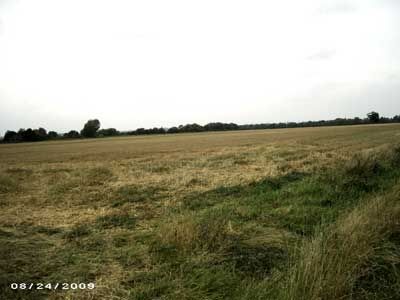
Part of the battlefield abuts the River Trent. According to what I’ve read, the far bank is high, which you can see here, but now the bank has a retaining wall, which undoubtedly wasn’t there in 1487.
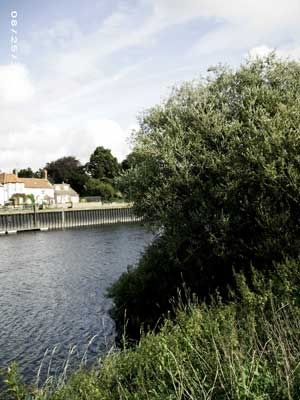
Next research stop was Witney--noted for wool and woolen blanket production--and Minster Lovel Hall, about three miles upstream from Witney on Windrush River.
Buttercross Market Square
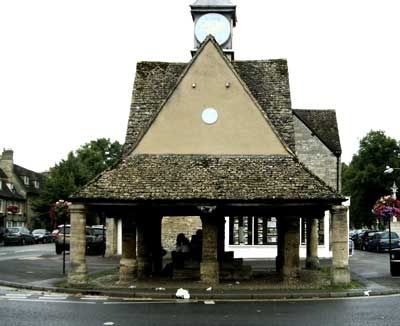
Windrush between Witney and the Cogges, a medieval farm

Minster Lovel Hall from the Windrush

Windrush at the edge of Minster Lovel Hall
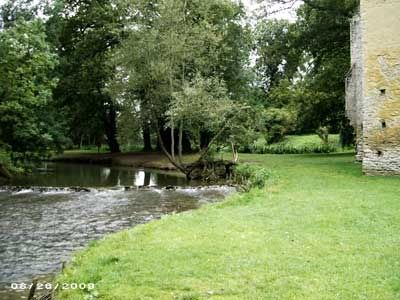
My research for the third book done, I drove to Reading to see my friends from way back and returned the car. I still needed to do a bit of research for an unrelated book, so I split my time between visiting with my friends and taking the train into London. Part of this research brought me back to the tower, but now to see the Royal Chapel of St. Peter ad Vincula where certain headless royalty were buried.
Tower of London from the underground stop

St. Peter ad Vincula (grassy foreground is where several people lost their heads, including William Hastings.
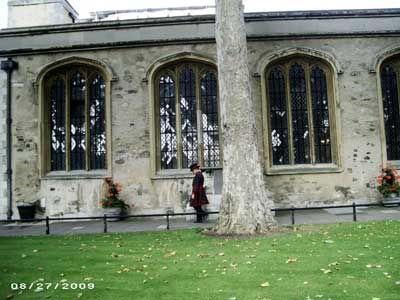
On my last day, I met with Annette Carson and we traded books. She also gave me two signed copies for the US AGM's sales table. Her book, Richard III, the Maligned King is well worth reading. I'm about half way through it and I'm singularly impressed with the quality of research and writing. I plan on reviewing this and Peter Hancock's book shortly.
My first stop was the Battle of Bosworth reenactment to promote my book, This Time. I met up with two Ricardian friends who formed a partnership called White Boar and to my joy and gratitude have agreed to distribute my book in the UK. The Heritage Center set me up with a small table and although I had some stiff competition from Philippa Gregory who was there signing her latest book, I did manage to sell 14 signed copies of mine. But the best news is the Heritage Center shop bought 10 copies from White Boar for sale at their shop. I signed those copies as well. Then, the cherry on top of the icing on the cake was the Richard III Society’s tent was next to us, and they gave White Boar a spot at their AGM (annual meeting) where more of my books will be available. And Phil Stone, the society’s chairman bought a copy.
It’s a good thing I got to see the reenactment in 2006, because I was pretty much tied to my table the whole time. Except for bio breaks, this was my view of the reenactment.

The second reason for my trip was to do some research for the third book, Strange Times (still a work in progress). To do this, I needed to rent a car because a few of the places I needed to see are not near public transportation or sufficiently out of the way so that I’d eat up my time just getting to a place. My mantra became “keep left, left turn on side, right turn cross over.” I kept repeating it over and over and didn’t have any problems adjusting.
Since the novel begins at the end of the Battle of Stoke with Henry VII’s troops roundly defeating the Yorkist rebels, I had to see and walk over some of the ground where the battle took place. Unfortunately, much of the land is privately owned and being farmed.

Part of the battlefield abuts the River Trent. According to what I’ve read, the far bank is high, which you can see here, but now the bank has a retaining wall, which undoubtedly wasn’t there in 1487.

Next research stop was Witney--noted for wool and woolen blanket production--and Minster Lovel Hall, about three miles upstream from Witney on Windrush River.
Buttercross Market Square

Windrush between Witney and the Cogges, a medieval farm

Minster Lovel Hall from the Windrush

Windrush at the edge of Minster Lovel Hall

My research for the third book done, I drove to Reading to see my friends from way back and returned the car. I still needed to do a bit of research for an unrelated book, so I split my time between visiting with my friends and taking the train into London. Part of this research brought me back to the tower, but now to see the Royal Chapel of St. Peter ad Vincula where certain headless royalty were buried.
Tower of London from the underground stop

St. Peter ad Vincula (grassy foreground is where several people lost their heads, including William Hastings.

On my last day, I met with Annette Carson and we traded books. She also gave me two signed copies for the US AGM's sales table. Her book, Richard III, the Maligned King is well worth reading. I'm about half way through it and I'm singularly impressed with the quality of research and writing. I plan on reviewing this and Peter Hancock's book shortly.
Sunday, August 16, 2009
Myth--Henry Stafford made to marry an older woman--Katherine Woodville
I must thank Susan Higginbotham for the idea to include it as part of the myth-busting series from her Medieval Woman blog post on this topic where she points out that Katherine was about two years Henry’s junior.
My first search was for statements indicating this was a May/September match as some writers of both fiction and non-fiction have recently used to give reason for Stafford’s apparent contempt for his marriage. Interestingly, even the secondary sources I’ve investigated don’t make that claim.
Neither Kendall (1955) nor Ross (1997) claims that Katherine was twice Buckingham’s age when he was made to marry her when he was a boy.
Could it have been confused by some with the John Woodville (aged 20) match to Katherine Neville (aged 65) in 1465 (per Charles Ross in ‘Edward IV’ p 93?) Please forgive any typos I may have introduced transcribing the snippets.
“..In January 1465 the queen brought off a less suitable match -- the marriage of her younger brother, John Woodville, then aged about twenty, to the very wealthy dowager duchess of Norfolk, Katherine Nevill[e], who was then a ‘slip of a girl’ (juvencula) of at least sixty-five,...
“Aristocratic husbands were soon found for three more of the queen’s sisters. Their betrothals or marriages seem to have taken place soon after the baptism of the royal couple’s first child, Elizabeth of York, who was born on 11 February 1466. Katherine Woodville married Henry Stafford, grandson and heir of the duke of Buckingham;...”
So, even if Ross has the year wrong, he doesn’t explicitly state that Katherine was much older than Buckingham and the implication is a stretch since he mentions other matches with the Katherine Woodville/Henry Stafford match.
According to Ross, Stafford’s objection was one of wealth and inheritance in that the Woodvilles had little money and were considered upstarts.
Per the Royal Genealogy at Hull, Catherine Wydeville was born 1458, married Henry Stafford in February of 1466 and died in 1497. The same site gives Henry Stafford’s birth as September 4, 1455 and also lists five children from that marriage.
Then, the real mystery is why and how the myth that Katherine was about twelve years Buckingham’s senior has been assumed as fact by some recent writers of both fiction and non-fiction.
Interesting aside from ‘The dictionary of English history’ by Sir Sidney Low as to why Buckingham turned against Richard:

My first search was for statements indicating this was a May/September match as some writers of both fiction and non-fiction have recently used to give reason for Stafford’s apparent contempt for his marriage. Interestingly, even the secondary sources I’ve investigated don’t make that claim.
Neither Kendall (1955) nor Ross (1997) claims that Katherine was twice Buckingham’s age when he was made to marry her when he was a boy.
Could it have been confused by some with the John Woodville (aged 20) match to Katherine Neville (aged 65) in 1465 (per Charles Ross in ‘Edward IV’ p 93?) Please forgive any typos I may have introduced transcribing the snippets.
“..In January 1465 the queen brought off a less suitable match -- the marriage of her younger brother, John Woodville, then aged about twenty, to the very wealthy dowager duchess of Norfolk, Katherine Nevill[e], who was then a ‘slip of a girl’ (juvencula) of at least sixty-five,...
“Aristocratic husbands were soon found for three more of the queen’s sisters. Their betrothals or marriages seem to have taken place soon after the baptism of the royal couple’s first child, Elizabeth of York, who was born on 11 February 1466. Katherine Woodville married Henry Stafford, grandson and heir of the duke of Buckingham;...”
So, even if Ross has the year wrong, he doesn’t explicitly state that Katherine was much older than Buckingham and the implication is a stretch since he mentions other matches with the Katherine Woodville/Henry Stafford match.
According to Ross, Stafford’s objection was one of wealth and inheritance in that the Woodvilles had little money and were considered upstarts.
Per the Royal Genealogy at Hull, Catherine Wydeville was born 1458, married Henry Stafford in February of 1466 and died in 1497. The same site gives Henry Stafford’s birth as September 4, 1455 and also lists five children from that marriage.
Then, the real mystery is why and how the myth that Katherine was about twelve years Buckingham’s senior has been assumed as fact by some recent writers of both fiction and non-fiction.
Interesting aside from ‘The dictionary of English history’ by Sir Sidney Low as to why Buckingham turned against Richard:
Friday, July 24, 2009
In the spirit of Mythbusting...
Apollo 11 Moon Landing really happened.
Unfortunately, a small percentage of people in the conspiracy fringes hold that the 1969 moon landing never happened--it was all staged in a studio.
Nonsense! It really happened and is so well documented that it boggles my mind that about 6% of Americans think this glorious event was a hoax. So I'm pleased to share National Geographic's own Mythbusting article.
Unfortunately, a small percentage of people in the conspiracy fringes hold that the 1969 moon landing never happened--it was all staged in a studio.
Nonsense! It really happened and is so well documented that it boggles my mind that about 6% of Americans think this glorious event was a hoax. So I'm pleased to share National Geographic's own Mythbusting article.
Labels:
40th anniversary,
Apollo 11,
moon landing,
mythbusting
Tuesday, July 21, 2009
Horace Walpole: Vampires , Doubts, and Serendipity
I recently picked up The Vampyre: A Bedside Companion edited by Christopher Frayling and in the introduction I stumbled upon the name of Horace Walpole as having written what is often considered to be the first gothic novel (Castle of Otranto (1764)) based on a nightmare he’d had. “What?” thought I. “Could this have been written by the same Walpole who wrote Historic Doubts on the Life and Reign of Richard III (1768)?” A quick Google search revealed it was indeed the same person. So not only was he an early revisionist, but also a Gothic novel pioneer.
What I like about Doubts is that he questioned the prevailing “historical facts” of the time that Richard committed the following crimes:
1. His murder of Edward prince of Wales, son of Henry the Sixth.
2. His murder of Henry the Sixth.
3. The murder of his brother George duke of Clarence.
4. The execution of Rivers, Gray, and Vaughan.
5. The execution of Lord Hastings.
6. The murder of Edward the Fifth and his brother.
7. The murder of his own queen.
Because the executions are so well documented and there is no doubt that they did take place, Walpole instead questions More’s assumptions of Richard’s motivations.
Regardless of whether his conclusions were correct, the real value in Doubts for me is that he questioned the “facts” about Richard III and kept the door open for more research. As George Carlin said, “Question everything.”
So what does this have to do with serendipity? According to the article (cited) and the etymology given in The American Heritage Dictionary, Walpole is accredited with coining this word.
Horace Walpole
Historic Doubts
What I like about Doubts is that he questioned the prevailing “historical facts” of the time that Richard committed the following crimes:
1. His murder of Edward prince of Wales, son of Henry the Sixth.
2. His murder of Henry the Sixth.
3. The murder of his brother George duke of Clarence.
4. The execution of Rivers, Gray, and Vaughan.
5. The execution of Lord Hastings.
6. The murder of Edward the Fifth and his brother.
7. The murder of his own queen.
Because the executions are so well documented and there is no doubt that they did take place, Walpole instead questions More’s assumptions of Richard’s motivations.
Regardless of whether his conclusions were correct, the real value in Doubts for me is that he questioned the “facts” about Richard III and kept the door open for more research. As George Carlin said, “Question everything.”
So what does this have to do with serendipity? According to the article (cited) and the etymology given in The American Heritage Dictionary, Walpole is accredited with coining this word.
Horace Walpole
Historic Doubts
Friday, July 10, 2009
Myth: Richard and Anne were childhood sweethearts
Since, by his actions, Richard appeared to be faithful to Anne throughout his marriage (although there is some indication that he may have strayed once or twice) and he seemed to genuinely mourn his wife’s death, many Ricardians retrofitted these behaviors and flat-footedly declared that he therefore must have been in love with her since his childhood.
Regardless of Richard’s motivations to marry Anne--and surely Anne’s inheritance played some major part--his behavior is the more telling as to his feelings for his wife once they were married. For one, in order to marry Anne, Richard had to effectively accept a prenuptial that denied transfer of Anne’s inheritance to him (the amount granted as condition that Clarence drop his claim) should their marriage end in divorce. (I could only find second hand reference to this in Markham and Kendall and this from Croyland:
“...At last, their most loving brother, king Edward, agreed to act as mediator between them; and in order that the discord between princes of such high rank might not cause any hindrance to the carrying out of his royal intentions in relation to the affairs of France, the whole misunderstanding was at last set at rest, upon the following terms: the marriage of the duke of Gloucester with Anne before-named was to take place, and he was to have such and so much of the earl's lands as should be agreed upon between them through the mediation of arbitrators; while all the rest were to remain in the possession of the duke of Clarence...”
However, I found a mystery surrounding the marriage. Up until the publication of Peter Clarke’s article in 2005 on English Royal Marriages and the Papal Penitentiary, it was thought that Richard married Anne without the requisite Papal dispensation. According to this article: “...they had sought a dispensation to marry from the penitentiary in early 1472, for it was granted on 22 April that year, and they were probably married shortly afterwards.” So, by the date on the dispensation, they should have been married no earlier than the end of April of that year (allowing time for the dispensation to reach them). But according to a letter (690) written by John Paston on the 17th of February 1472, Richard and Anne had already married! This predates the dispensation. If the date on Paston’s letter is accurate, then Richard and Anne must have wedded without this document, but only with the assurance that they would get it soon.
Assuming these dates are correct and that Richard had less to gain from the marriage because the “spoils” were divided between Anne and her sister, Isabel and possibly because Richard would be left with little if they divorced, can one conclude that by the time of their marriage, Richard was following his heart?
Reference:
Clarke, Peter D. English Royal Marriages and the Papal Penitentiary in the Fifteenth Century. English Historical Review Vol. CXX No. 488. 2005
Croyland Chronicle Continuations, 1453-1486. Richard III Society, American Branch http://www.r3.org/bookcase/croyland/index.html
Gairdner, James. The Paston Letters 1422-1509 A.D. Volume III, Westminster. Archibald Constable and Co., Ltd. 1900. Letter 690


Kendall, Paul Murray. Richard the Third. New York. W. W. Norton & Company Inc. 1955.
Markham, Sir Clements R. Richard III: His Life & Character Reviewed in the Light of Recent Research. New York. Russell & Russell. First published 1906 (rescued 1968 by Russell & Russell).
Regardless of Richard’s motivations to marry Anne--and surely Anne’s inheritance played some major part--his behavior is the more telling as to his feelings for his wife once they were married. For one, in order to marry Anne, Richard had to effectively accept a prenuptial that denied transfer of Anne’s inheritance to him (the amount granted as condition that Clarence drop his claim) should their marriage end in divorce. (I could only find second hand reference to this in Markham and Kendall and this from Croyland:
“...At last, their most loving brother, king Edward, agreed to act as mediator between them; and in order that the discord between princes of such high rank might not cause any hindrance to the carrying out of his royal intentions in relation to the affairs of France, the whole misunderstanding was at last set at rest, upon the following terms: the marriage of the duke of Gloucester with Anne before-named was to take place, and he was to have such and so much of the earl's lands as should be agreed upon between them through the mediation of arbitrators; while all the rest were to remain in the possession of the duke of Clarence...”
However, I found a mystery surrounding the marriage. Up until the publication of Peter Clarke’s article in 2005 on English Royal Marriages and the Papal Penitentiary, it was thought that Richard married Anne without the requisite Papal dispensation. According to this article: “...they had sought a dispensation to marry from the penitentiary in early 1472, for it was granted on 22 April that year, and they were probably married shortly afterwards.” So, by the date on the dispensation, they should have been married no earlier than the end of April of that year (allowing time for the dispensation to reach them). But according to a letter (690) written by John Paston on the 17th of February 1472, Richard and Anne had already married! This predates the dispensation. If the date on Paston’s letter is accurate, then Richard and Anne must have wedded without this document, but only with the assurance that they would get it soon.
Assuming these dates are correct and that Richard had less to gain from the marriage because the “spoils” were divided between Anne and her sister, Isabel and possibly because Richard would be left with little if they divorced, can one conclude that by the time of their marriage, Richard was following his heart?
Reference:
Clarke, Peter D. English Royal Marriages and the Papal Penitentiary in the Fifteenth Century. English Historical Review Vol. CXX No. 488. 2005
Croyland Chronicle Continuations, 1453-1486. Richard III Society, American Branch http://www.r3.org/bookcase/croyland/index.html
Gairdner, James. The Paston Letters 1422-1509 A.D. Volume III, Westminster. Archibald Constable and Co., Ltd. 1900. Letter 690
Kendall, Paul Murray. Richard the Third. New York. W. W. Norton & Company Inc. 1955.
Markham, Sir Clements R. Richard III: His Life & Character Reviewed in the Light of Recent Research. New York. Russell & Russell. First published 1906 (rescued 1968 by Russell & Russell).
Labels:
Anne Neville,
childhood sweethearts,
marriage,
mythbusting,
Richard III
Monday, July 6, 2009
Deer update
Thursday, July 2, 2009
Deer returns
I looked out my front door yesterday and was greeted by this sight:


I thought it was curious that the deer seemed to be resting in the open (sort of) in the middle of the day and even wondered if it had the equivalent of 'mad cow' disease. Later, however, my mate noticed a fawn and this deer cavorting on my neighbor's lawn. Was she giving birth in my front yard? Wish I had stayed at the door watching. What a sight that would have been!


I thought it was curious that the deer seemed to be resting in the open (sort of) in the middle of the day and even wondered if it had the equivalent of 'mad cow' disease. Later, however, my mate noticed a fawn and this deer cavorting on my neighbor's lawn. Was she giving birth in my front yard? Wish I had stayed at the door watching. What a sight that would have been!
Friday, June 19, 2009
Deer in my back yard
I happened to look out my kitchen window the other day and saw this sight:


(click on each thumbnail for full view)
I live about 15 miles north of New Haven, Connecticut and while there are some small farms, the town is pretty much a part of suburbia. But we do have our share of wild life. In addition to the deer population, there are coyotes, red fox, ground hogs, raccoons, opossum, kestrels, hawks, eagles, owls, and a variety of birds, which I'm crap at identifying beyond little yellow bird, little black and white bird, and the more readily identifiable crows, blue jays, and wood peckers.


(click on each thumbnail for full view)
I live about 15 miles north of New Haven, Connecticut and while there are some small farms, the town is pretty much a part of suburbia. But we do have our share of wild life. In addition to the deer population, there are coyotes, red fox, ground hogs, raccoons, opossum, kestrels, hawks, eagles, owls, and a variety of birds, which I'm crap at identifying beyond little yellow bird, little black and white bird, and the more readily identifiable crows, blue jays, and wood peckers.
Wednesday, June 17, 2009
Myth busting series: Did Edward V have a diseased jaw?
In 1674, workers at the Tower of London exposed bones of two children in a pit ten feet deep under a stairwell that was part of the White Tower. About four days after the bones were found, Charles II, then king of England, declared these bones were those of the princes and placed in an urn in Henry VII’s chapel in Westminster Abbey after giving them a funeral. In 1933 Professor Wright examined the bones and concluded the lower jaw of the older child was diseased. If Edward V had a diseased or infected jaw, then this finding would strengthen the theory that the bones belonged to the princes. But did he?
I could find no specific mention of Edward V having had a diseased jaw or having serious health problems in searching through contemporary documentation. The one mention I did find is from Mancini’s Usurpation: “...the young king, Edward V, felt himself to be awaiting death in the Tower.” Mancini mentions Argentine (Edward V’s physician) by name but doesn’t claim to have received this information directly from Argentine.
Edward may well have feared for his life since the important members of his entourage (Rivers, Grey, and Vaughan) had been arrested, held for treason and later executed.
The next account is found in More’s History of King Richard the Third (not contemporary, but he did have access to people who were Richard III’s contemporaries). The dowager Queen, Elizabeth protested that the younger prince “...nedeth good loking to, hath a while ben so sore diseased vexed with sicknes, and is so newly rather a lyttle amended then well recouered...” While this is hearsay, she may well have protested in this manner in an attempt to keep Richard of York with her in sanctuary rather than give him up to their uncle. In any case, even More’s account doesn’t say that Edward was ill.
Another factor may be from the excavation and examination of bones from a cousin, Anne Mowbray. The bones showed she had a rare congenital absence of both left second molars. According the to the 1965 article on Anne Mowbray’s teeth, the older of the tower bones shows the distal maxillary premolars had failed to develop and the younger of the bones had a suppressed second milk molar.
In the absence of DNA evidence that would match the bones’ DNA to Elizabeth Woodville and Edward IV, and facial reconstruction using the skulls and then seeing if either skull matches up with portraits of Edward V, this, for me, is the most convincing argument that the bones could be those of the princes.
References:
C. A. J. Armstrong, ed., The Usurpation of Richard III, Oxford, Oxford University Press, 1936.
Bertram Fields, Royal Blood, New York, ReganBooks, 2000.
Thomas More, The History of King Richard the Third, online at University of Oregon, read here.
Article on Anne Mowbray’s teeth from Br Med J, v.2(5477); Dec 25, 1965, link to PDF excerpt.
I could find no specific mention of Edward V having had a diseased jaw or having serious health problems in searching through contemporary documentation. The one mention I did find is from Mancini’s Usurpation: “...the young king, Edward V, felt himself to be awaiting death in the Tower.” Mancini mentions Argentine (Edward V’s physician) by name but doesn’t claim to have received this information directly from Argentine.
Edward may well have feared for his life since the important members of his entourage (Rivers, Grey, and Vaughan) had been arrested, held for treason and later executed.
The next account is found in More’s History of King Richard the Third (not contemporary, but he did have access to people who were Richard III’s contemporaries). The dowager Queen, Elizabeth protested that the younger prince “...nedeth good loking to, hath a while ben so sore diseased vexed with sicknes, and is so newly rather a lyttle amended then well recouered...” While this is hearsay, she may well have protested in this manner in an attempt to keep Richard of York with her in sanctuary rather than give him up to their uncle. In any case, even More’s account doesn’t say that Edward was ill.
Another factor may be from the excavation and examination of bones from a cousin, Anne Mowbray. The bones showed she had a rare congenital absence of both left second molars. According the to the 1965 article on Anne Mowbray’s teeth, the older of the tower bones shows the distal maxillary premolars had failed to develop and the younger of the bones had a suppressed second milk molar.
In the absence of DNA evidence that would match the bones’ DNA to Elizabeth Woodville and Edward IV, and facial reconstruction using the skulls and then seeing if either skull matches up with portraits of Edward V, this, for me, is the most convincing argument that the bones could be those of the princes.
References:
C. A. J. Armstrong, ed., The Usurpation of Richard III, Oxford, Oxford University Press, 1936.
Bertram Fields, Royal Blood, New York, ReganBooks, 2000.
Thomas More, The History of King Richard the Third, online at University of Oregon, read here.
Article on Anne Mowbray’s teeth from Br Med J, v.2(5477); Dec 25, 1965, link to PDF excerpt
Labels:
Anne Mowbray,
diseased jaw,
Edward V,
mythbusting,
tower bones
Monday, June 15, 2009
Really cool search tool using Google Books
Google Books 'my library' button doesn't just allow you to catalog the books you own on their site, but also allows you to search those books electronically.
From the TYWKIWBDI blog:
"Most web users are at least marginally aware of Google Books. I frankly had not been aware that the site has a "my library" feature, which allows you to import the books you have on your own bookshelves. You can do this by searching Google Books for the title you have and then clicking "add to my library," or you can go to your library list, click import books, and type in the ISBN. The video above also shows that with a handheld scanner (or using your computers webcam and appropriate software) to can rapidly add large numbers of books to the database.
The advantage of compiling "your library" in this fashion is, of course, that when you search Google Books for a keyword or phrase or topic, you can opt to search only the books you already have at home. Nice.
Info found at The Centered Librarian, a blog created by/for librarians but of interest to any serious bibliophile."
You don't need a handheld barcode scanner to enter books into 'my library'. search for the book by title and then click the 'my library' button to add the book. Like the blog's writer, I had no idea what "my library" did for me. Now, I can use Google books to search my print books electronically. It's the best of both worlds!
note: I know I've posted this information on numerous boards and discussion groups--but I think this information bears repeating.
From the TYWKIWBDI blog:
"Most web users are at least marginally aware of Google Books. I frankly had not been aware that the site has a "my library" feature, which allows you to import the books you have on your own bookshelves. You can do this by searching Google Books for the title you have and then clicking "add to my library," or you can go to your library list, click import books, and type in the ISBN. The video above also shows that with a handheld scanner (or using your computers webcam and appropriate software) to can rapidly add large numbers of books to the database.
The advantage of compiling "your library" in this fashion is, of course, that when you search Google Books for a keyword or phrase or topic, you can opt to search only the books you already have at home. Nice.
Info found at The Centered Librarian, a blog created by/for librarians but of interest to any serious bibliophile."
You don't need a handheld barcode scanner to enter books into 'my library'. search for the book by title and then click the 'my library' button to add the book. Like the blog's writer, I had no idea what "my library" did for me. Now, I can use Google books to search my print books electronically. It's the best of both worlds!
note: I know I've posted this information on numerous boards and discussion groups--but I think this information bears repeating.
Mythbusting
Taking a cue from the TV show, Mythbusters, I thought it would be fun to "bust" some myths that surround Richard III. The obvious one that he was physically deformed has been thoroughly debunked, but there are other myths that have become popular "truths" that bear scrutiny. Two myths that immediately come to mind are that Richard III and Francis Lovel were childhood friends and that Richard's nephew, Edward V had a diseased jaw.
I invite readers of this blog to suggest more myths for discussion.
I invite readers of this blog to suggest more myths for discussion.
Subscribe to:
Comments (Atom)


